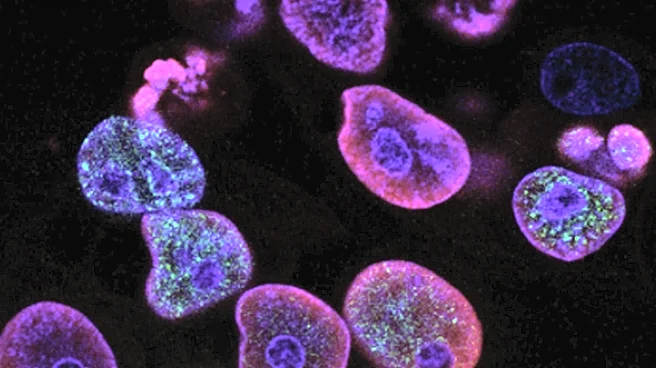What is the story about?
What's Happening?
Recent research has identified transferrin (TF) as a promising drug candidate for treating dry age-related macular degeneration (AMD). The study highlights the protective effects of TF against oxidative stress, mitochondrial damage, inflammation, complement activation, and ferroptosis in retinal pigment epithelium (RPE) cells. Patients with AMD were found to have higher levels of iron saturation in transferrin compared to those without the condition, suggesting an imbalance that contributes to the disease's progression. The research demonstrated that TF supplementation can preserve cell viability and integrity in RPE cells exposed to oxidative stress and iron overload, which are key pathological mechanisms associated with AMD.
Why It's Important?
The identification of transferrin as a potential treatment for dry AMD is significant because it addresses the underlying mechanisms of the disease, which affects millions of people worldwide. AMD is a leading cause of vision loss among older adults, and current treatments are limited. By targeting iron overload and oxidative stress, transferrin could offer a new therapeutic approach that not only slows the progression of AMD but also improves the quality of life for patients. This research could pave the way for further clinical trials and development of transferrin-based therapies, potentially transforming the management of AMD.
What's Next?
Further research and clinical trials are needed to validate the efficacy and safety of transferrin as a treatment for dry AMD. Researchers will likely focus on optimizing the dosage and delivery methods of transferrin to maximize its protective effects on RPE cells. Additionally, studies may explore the potential of transferrin in combination with other treatments to enhance its therapeutic benefits. If successful, transferrin-based therapies could become a standard treatment option for AMD, offering hope to patients who currently have limited options.
Beyond the Headlines
The study of transferrin in AMD treatment also raises broader questions about the role of iron metabolism in other neurodegenerative diseases. Understanding how iron imbalance contributes to cellular damage could lead to breakthroughs in treating conditions like Alzheimer's and Parkinson's disease. Moreover, the research highlights the importance of personalized medicine, as individual variations in iron metabolism may influence treatment outcomes. Ethical considerations regarding access to new treatments and the cost of drug development may also emerge as transferrin therapies progress.
AI Generated Content
Do you find this article useful?













